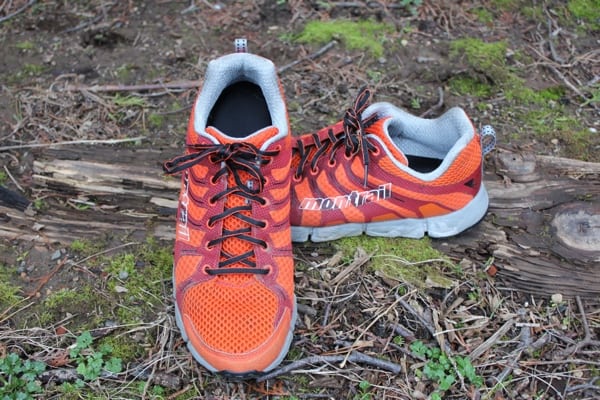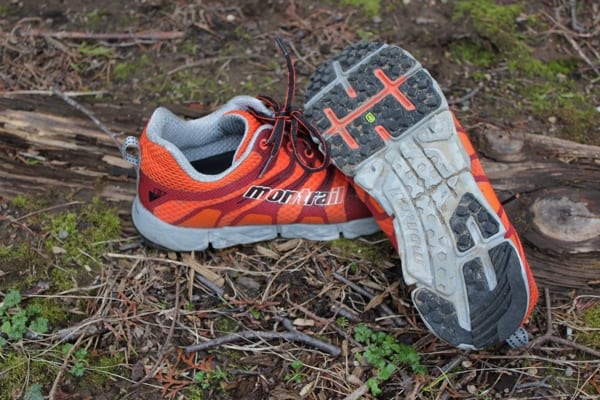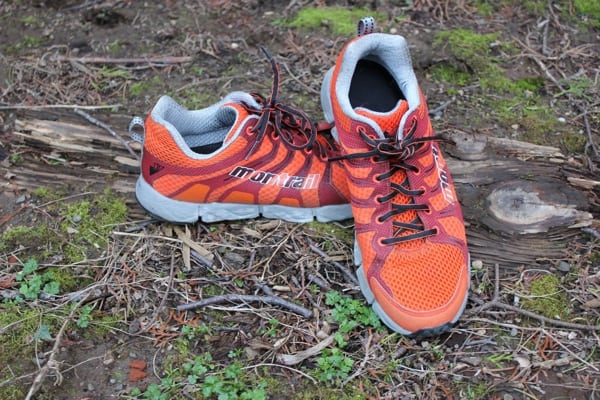Our Favorite Trail Running Shoes
Check out our Best Trail Running Shoes article to learn about our current favorite trail running shoes!
Montrail FluidFlex ST Review
Low to the ground, lightweight, a race-y feel, and with a touch of stability? Yes please! Stability and fast tend to not go together very often but Montrail decided to go out and mix those two ingredients up in the Montrail FluidFlex ST ($95). The FluidFlex ST is the slightly anti-pronating sibling of the FluidFlex. Both shoes have a lot in common when it comes to the shape of the upper, the flexy grooves in the midsole, and even their tread patterns. Where they differ slightly is with what is in the midsole. Montrail uses their FluidFrame technology, which is a mixture of varying-density foams, to add some slight stability to this model where the original FluidFlex stays neutral. Check out the video below for an in-depth look at this fast hybrid.
[Click here if you can’t see the video above.]
Montrail FluidFlex ST Review Transcript
Hey and welcome to Trail Trials, the video-review section of iRunFar.com. My name is Travis Liles, and in this video we’re going to take a look at the Montrail FluidFlex ST.
‘Flat and fast’ or ‘low and fast’ are terms that we’ve heard quite a bit here recently when it comes to trail running shoes. One of the really exciting parts of this industry is that it’s getting lower drops and lighter materials and the shoes have really come a long way. One of the ways it’s maybe not come as quickly is having a little bit of stability in some of those models as well. Someone like myself, I require a little bit of stability in my trail and road running shoes. So to get into that ‘low and fast’ type of flat was generally something that was hard for me to do and really be able to put a lot of miles on without feeling beat up and having some injury type of issues. I was really excited when Montrail decided to release a version of their FluidFlex that included stability. That’s actually what we’re going to look at in this video—the Montrail FluidFlex ST.
This is a 9-ounce shoe in a men’s size 9 with a 4-millimeter drop. What differentiates this from the standard FluidFlex model is the addition of this FluidFrame. This is something that we’ve covered looking at several other Montrail shoes in the past including the Montrail Mountain Masochist II. What we’re going to do is get up close and personal. We’ll take a look at the outsole; we’ll take a look at the midsole; we’ll take a look at the upper and any other comments we have about this. Then we’ll come back to conclusions.

The Montrail FluidFlex ST.
Outsole
Let’s start out by talking about the outsole. The first thing you’re going to notice is that this is not a full-length outsole in terms of the tread which also means it’s not a full-length outsole in terms of the rock plate. Up toward the toe, right behind the ball of the foot up, we have the classic Gryptonite traction or tread that comes from Montrail. It’s in this diamond type of pattern which we’ve seen on trail running shoes throughout Montrail’s line—the Bajada is one instance of that. These are a little bit shorter than that, so I’d say more of a general-purpose type of tread. Overall, I felt really good about these on varying types of surfaces—road, track, trail. They grip nice. If it’s wet, Gryptonite tends to do a nice job of being kind of sticky. You can see this diamond pattern throughout. You’ll also notice inside of here is a rock plate. That’s going to be on your forefoot. This is pointed toward that faster runner running out on your midfoot or forefoot type of area where you’re going to get the most amount of impact. So there’s a rock plate there.
When we move back to the heel, what we see is some of that diamond pattern continued. We have some braking, of course, here, with some reverse lugs here on the back corner. Then even a little bit more tread here. What you can probably guess here is that this is done to reduce weight. Put the tread where you’re going to strike with the most or you’re going to need the most amount of traction on. The midfoot area is completely exposed. This foam that you’re going to see here is the same foam that’s in the midsole. There’s not any differentiation between the two. This is just midsole without any type of tread on it. Of course, the positive of that is weight savings. The downside of that is that it’s going to wear faster. You can see, here’s one of the spots I tend to land right back here on the outside of my foot. You can actually probably get a view of that on both of these shoes in these areas. There’s some wear happening there. Then the other thing I’ll point out is quite simply that stuff pokes through here. It doesn’t deflect. It doesn’t have something hard. So it can come right through here a lot easier. In fact, right here in the middle of this letter ‘A’, there was a fairly good, sharp, pointy rock that went through here. I just happened to notice it when I was messing around. I pulled my sock liner out of these and saw that rock pointing through and pulled it out. So, I guess the positive here is that you’re saving weight. It’s a good, all-around type of outsole that’s on here, but depending on where you’re running at, you may want to make some decisions. If it’s got a lot of thorns, if it has really sharp rocks, this may not be the right type of outsole for that because it is exposed. Overall, it’s a very good outsole for a lot of different conditions.

The Montrail FluidFlex ST outsole.
Midsole
With that, let’s transition to the midsole a bit. What differentiates this from the other FluidFlex models is really simple—it’s this FluidFrame. What you’re going to see here is these multicolored midsole versus being just all one color, which you’ll notice on the other FluidFlex shoes. This has what’s known as the FluidPost system. Here, it’s called the FluidFrame. What that means is over a traditional post which tends to be a chunk of hard foam set here in the middle and meant to deflect you outward so you don’t land on this inside too much, Montrail has made this posting system which is more gradual. What happens is the grey foam is softer and the light-grey foam is harder. So versus having that abrupt type of push that’s going to kick your foot back out, it’s a more gradual way of doing it—hopefully safer on the trail, of course, when you have obstacles that you definitely don’t want your foot ramping to the outside too hard. It gives a little bit of stability while still maintaining that support and that safety all over. And again, you can just kind of feel all throughout the shoe that these are two different types of foams with varying densities in them—a really cool feature there.
Throughout the midsole which is not the FluidFrame, which is basically from the ball of the foot up and then the heel, is just single-density foam. Again, if you’re familiar with the other FluidFlex models, that is the same type of foam—a nice, soft type of foam that feels good on a lot of different surfaces. It’s a surprising amount of cushion in this shoe for as low and light as it is in a 4mm drop. Of course, these notches throughout, that’s the whole name of this FluidFlex is this flexing. You have these cutouts throughout the shoe that allow it to flex and bend, so it’s a pretty flexible shoe for being what it is and specifically with stability. Again, it’s a bit of a unicorn when it comes to all the different features—stability, lightweight, low-drop. Those are the types of things you don’t tend to see very much in a shoe that has stability in it.

The Montrail FluidFlex ST midsole.
Upper
As we move on to the upper, what you’re going to see is just a very simple upper with mesh throughout. You can see a layer of mesh on here and some overlays. These overlays are sewn—the red ones are. They’re not welded on. You can actually see a little bit of the thread on some of these if you get really close to it. With that, those are going to secure down to the shoe and give it your anchor points for your laces. They’re going to really help hold and lock that shoe in, something I felt this shoe did really well. Mesh all the way down to the midsole means they’re going to drain relatively quickly. I spent a lot of time in these out here in the Pacific Northwest and water drains well. I never really felt I was sloshing around too much.
When we move to the toe box, what we’re going to see is a little bit of reinforcement here. You have is some nylon here at the back that is sewn onto the mesh. Then you have some of this rubberized stuff painted on here that is bonded to it. Then the apex of the outsole comes up and adds even a little more stability, so keeping your toes from getting banged around. It’s a relatively nice toe box in terms of width. Again, for a ‘low and light’ shoe, I felt like I had plenty of room for my toes to expand without it being too sharp of a point while still adding enough structure in there that I didn’t feel like my toes were swimming around in there either. Montrail has always been a good fit for me, so I think if you’re a Montrail person you’re going to recognize this fit when you put it on. The same thing goes for the heel. There’s a structured heel to it, so there’s a heel cup. I felt like, again, this wraps fairly well in terms of locking my heel into place and giving myself a good fit. The tongue is gusseted up to about the fourth or maybe just above the fourth eyelet here. You’ll have that to keep the garbage out. The one last unique feature that I’ll call out here is something on the tongue. What you’ll notice here for the tongue stay, there’s actually two of them. There’s one on each side. Some previous models of Montrail, the Bajada is one for instance that I can think of, didn’t have one at all, or did and it didn’t work very well and the tongue just fell to the side. What’s really great about having one on each side is that it can’t fall one way or the other. It just keeps that tongue in place well which I think just makes an overall more comfortable fit.

The Montrail FluidFlex ST upper.
Conclusions
Wrapping up, I think the Montrail FluidFlex ST is a really great all-around shoe. I’ve done road running, trail running, track running, and I’ve been on the treadmill with it. You name it—it tends to do pretty well in all of those environments. It’s light; it’s low; it has that little bit of extra stability so someone like myself doesn’t have to feel that neutral type of shoe. It’s got a little bit of support in there from the FluidFrame. The only downside is this exposed midsole makes it really tough for the more aggressive and sharp types of trail and then the tread is just average. As an all-arounder, you can really do a lot in this shoe and really hit lots of different terrain and get a good low, fast-feeling shoe. With that in mind, check these out at Montrail’s website. Questions or comments, place those below the video. Thanks for watching. We’ll catch you next time.
Call for Comments (from Meghan)
- Have you run in the Montrail FluidFlex ST? If so, what do you think of its stability features? Does it provide enough for your needs? Do the stability features feel natural enough that they aren’t noticeable on the run?
- The Montrail FluidFlex line is known for the flexibility it provides. What are your thoughts on this feature?
- How about the upper? Can you share your experiences with drainage, lock down, debris entering the shoe via the mesh, and more?
- On what surfaces have you found the outsole to perform well? And when would you have liked more traction?
